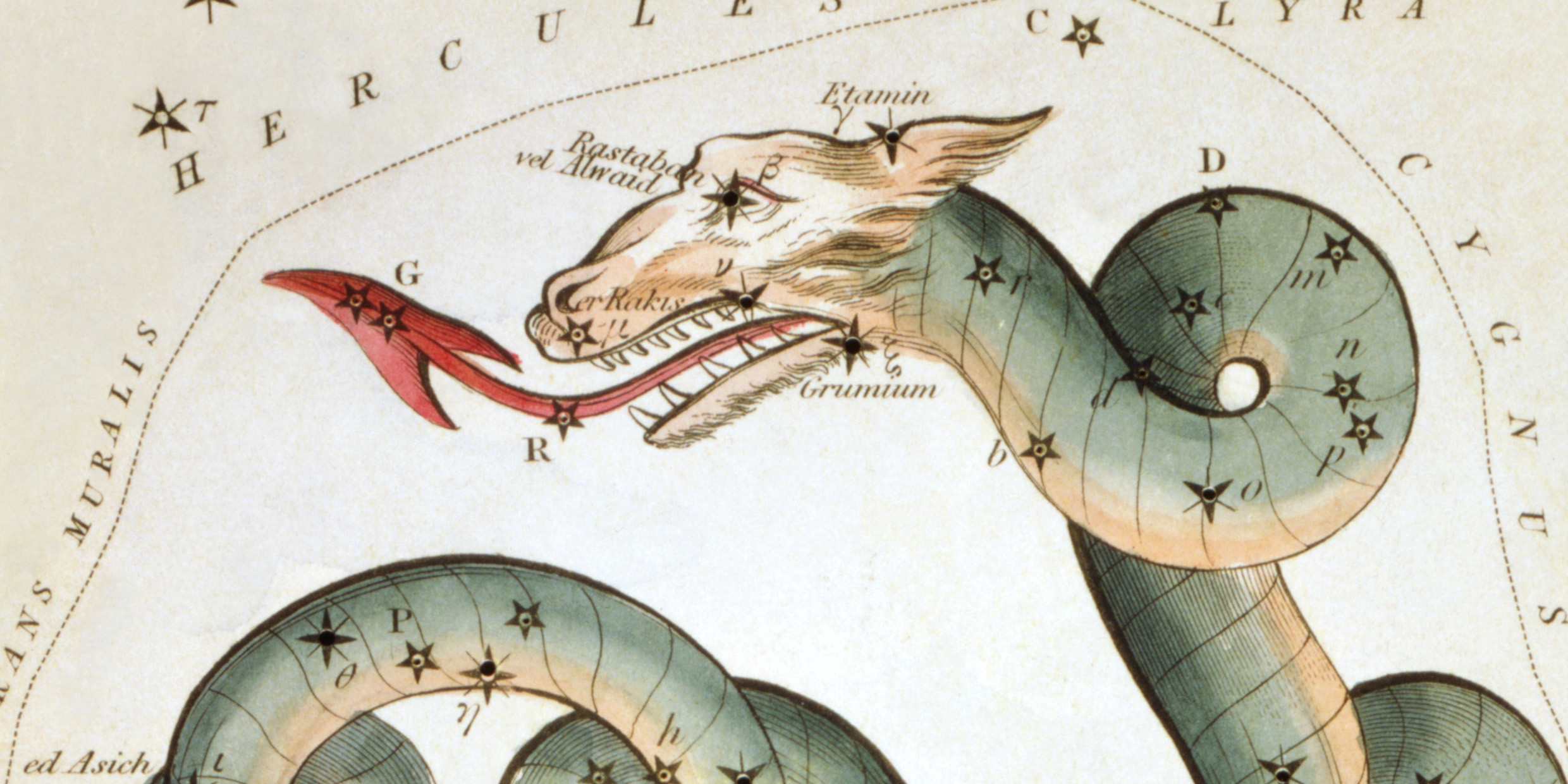Originally published 7 August 2005
If the Royal Observatory at Greenwich has a royal star, it has to be Gamma Draconis, also known as Eltanin, “the dragon’s head.” Eltanin is not an especially bright star, in a constellation, Draco, the Dragon, without any bright stars. But it does have a claim to local fame: It passes directly overhead London once each day.
In 1669, Robert Hooke, Isaac Newton’s nemesis, proposed to observe Gamma Draconis throughout the course of a year, hoping to detect its parallax. Parallax: a fancy word for a common notion. Hold your finger up in front of your nose. Now look at it first with one eye, then the other. Notice how your finger seems to move against the more distant background. That’s parallax: an apparent change in the position of an object when viewed from two different places. Notice also that as you move your finger farther away from your nose, the apparent shift becomes less. The greater the distance of the observed object, the less the parallax. What Hooke hoped to see was a change in the apparent position of Gamma Draconis due to the Earth’s motion in its orbit.
Success, he knew, would make him famous. He would have provided the first unambiguous proof that the Earth moves through space as Copernicus had proposed. And more, he would be the first to measure directly the distance to a star.
Not that Hooke needed another feather in his cap. He was already acknowledged as one of the cleverest natural philosophers of his time, a new Leonardo. In 1662 he had been appointed Curator of Experiments for the newly-created Royal Society, and in the following years he contrived an extraordinary range of experiments and inventions. Vacuum pump, air compressor, universal joint, iris diaphragm (today used in cameras), spiral spring for clocks, barometer, hygrometer, wind gauge, clock-driven telescope: His fertile mind cranked out one useful device after another. His international reputation was assured with the publication in 1665 of Micrographia, a wondrous compendium of the world of the very small revealed by the newly invented microscope. The diarist Samuel Pepys called it “the most ingenious book that I have ever read in my life.”
Strange fellow, Hooke. A sickly, stooped, pop-eyed man, afflicted with an assortment of uncertain maladies, including, no doubt, hypochondria. A nervous, cantankerous insomniac, jealous of his fame, quick to put down others. He seems to have intuited the inverse square law of gravity before Newton, but he lacked the patience and mathematical skill to do what Newton did — apply the law to both terrestrial and celestial motions. Today his name appears in science books only in association with the elastic law of springs, not a particularly fundamental insight into the workings of nature. Like Leonardo, his restless mind flitted so nimbly from topic to topic that he seems never to have followed through any idea fully. So it was with his 1669 proposal — to measure stellar parallax.
Hooke knew the stars were very far away (like others of his time, he supposed they were other Suns), and that the parallax would be small. If, in the 17th century, you wanted to measure the position of a star with exceeding accuracy there were advantages to choosing a star that passes near the zenith (the point directly overhead). First, gravity defines the zenith exactly; one need only align a telescope with a plumb bob to be sure that it pointed vertically. Second, the star’s light passes perpendicularly through the Earth’s atmosphere, so it will not be subject to refraction, the bending of light that occurs when light passes obliquely through any transparent medium.
Hooke cut holes through the interior ceilings and roof of his apartment at Gresham College in London, and set up a thirty-six-foot-long vertical telescope, aligned with a plumb bob. With this he watched Gamma Draconis transit near the zenith, carefully ascertaining its angular distance from the zenith point. He made measurements on July 6, July 9, August 6, and October 21, all in the year 1669, and thought he observed a tiny shift of 1/100th of a degree. But he was not at all certain that his apparatus worked reliably, and had little confidence in this result. After less than a handful of observations, he abandoned the project due to “inconvenient weather and great indisposition to my health.”
And just as well. It turns out that Gamma Draconis’s parallax is less than a thousandth of what Hooke thought he had — with great difficulty! — measured. The actual parallax of a star would not be measured until the German astronomer Friedrich Wilhelm Bessel pulled off the trick in 1838.
Still, give Hooke his due. He had a go at measuring the distance to a star, and established an experimental plan that others would follow. If he didn’t find the distance to Gamma Draconis, or see the annual wobble in the star’s apparent position that proved the Earth moves, he at least confirmed more reliably than anyone before that if the Earth does move the stars are very far away indeed.



